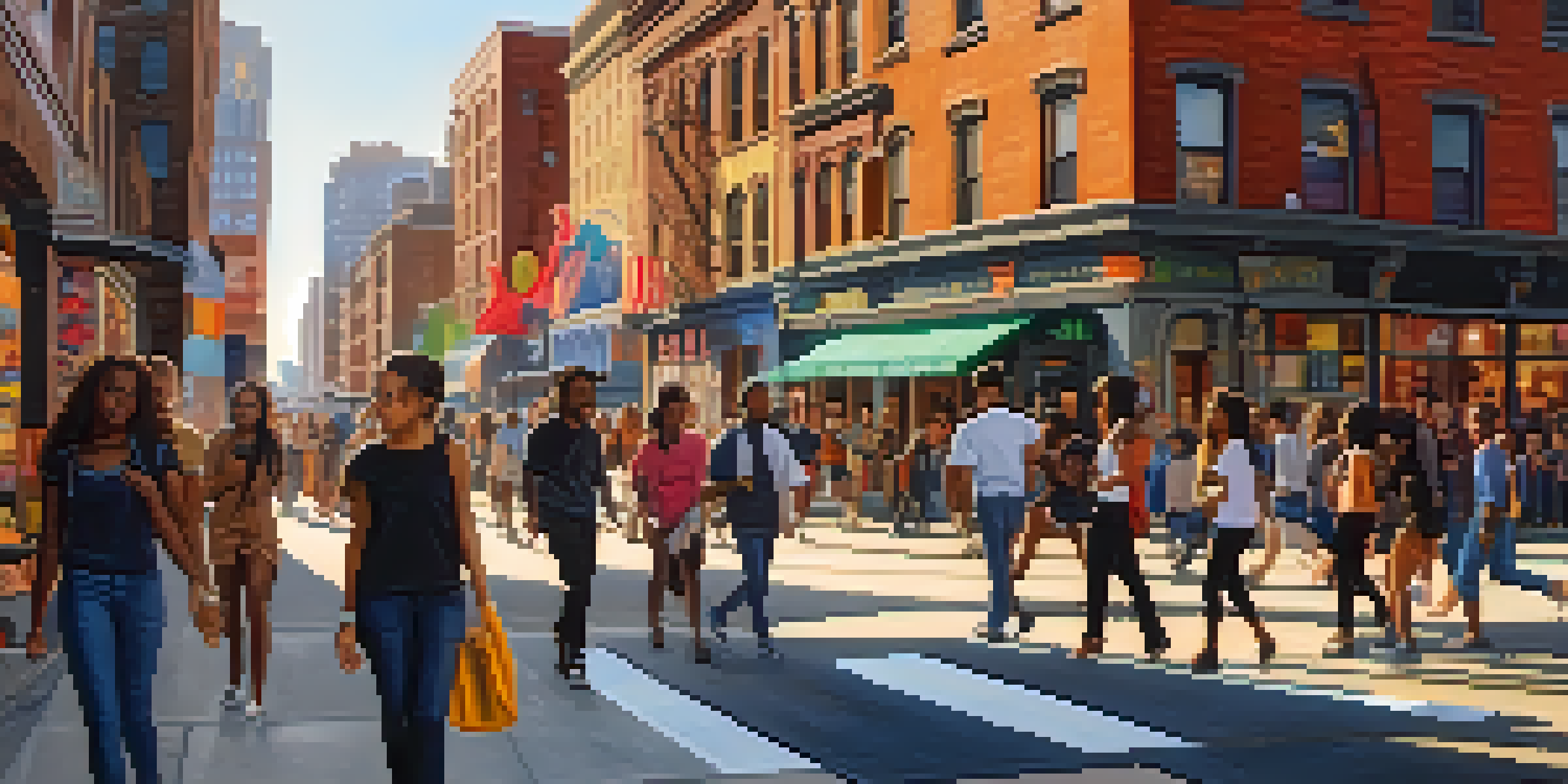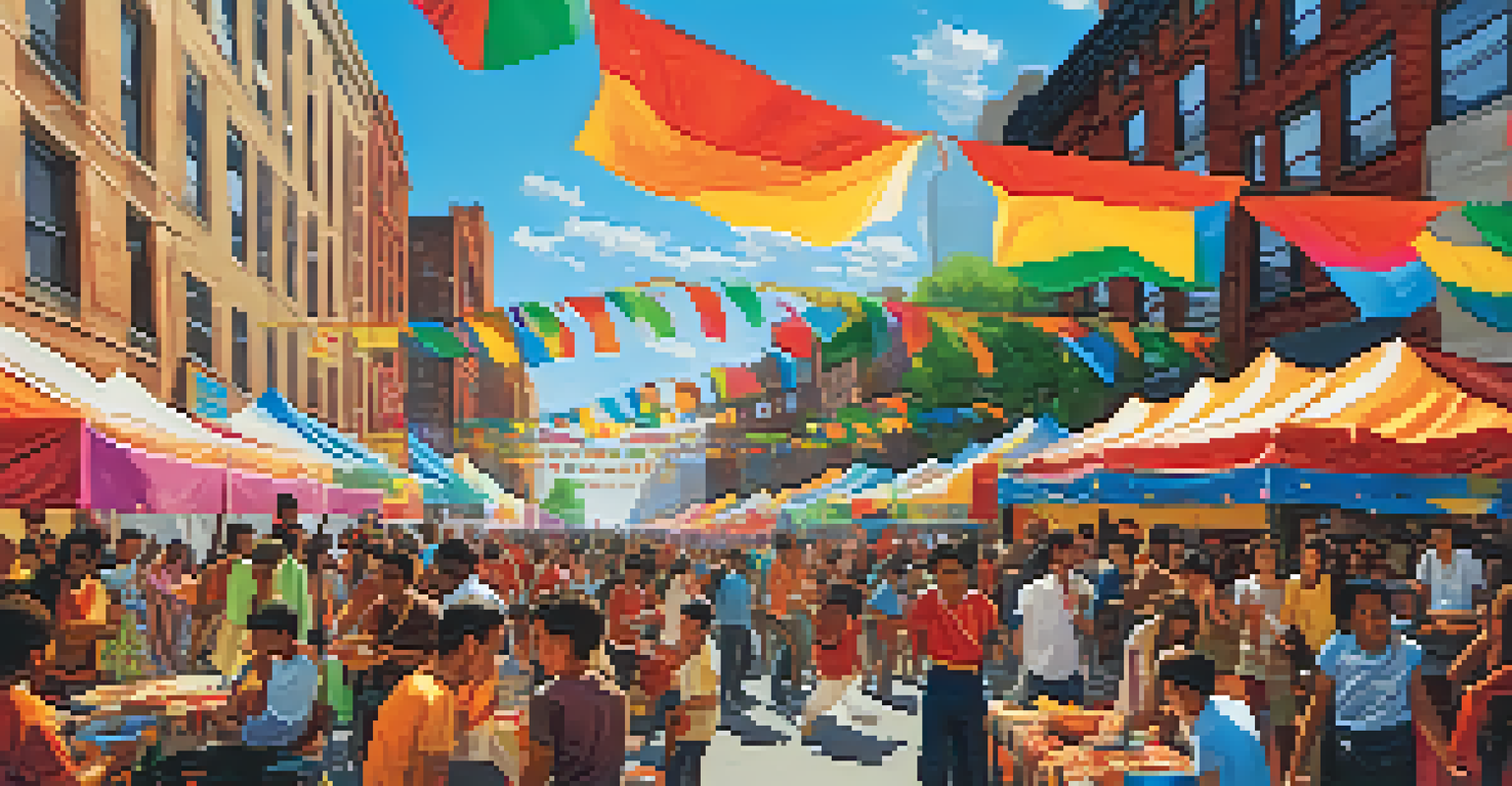Youth and Migration: The Future of NYC’s Demographics

Understanding Youth Migration in NYC
Youth migration has become a significant trend in New York City, driven by factors like education, employment opportunities, and quality of life. Young people often move to urban centers in search of vibrant communities and dynamic job markets that promise growth and innovation. In NYC, this influx of youth adds a unique flavor to the city's already diverse demographic landscape.
New York is not a city, it's a world.
For many, the allure of NYC's cultural richness and endless possibilities is irresistible. Whether it's the arts scene, tech startups, or fashion hubs, the city offers numerous avenues for young people to explore their passions and ambitions. This migration is not just about numbers; it's about the stories and experiences that these young individuals bring with them.
As they settle into the city, these newcomers contribute significantly to local economies, social networks, and cultural expressions. The impact of their presence can be seen in everything from new cafes and restaurants to community initiatives and creative projects. Understanding this phenomenon is crucial for grasping the future of NYC's demographics.
The Economic Impact of Youth Migration
Youth migration plays a pivotal role in driving New York City's economy forward. When young individuals relocate to the city, they often bring fresh ideas, innovative approaches, and a strong work ethic that can invigorate various sectors. This infusion of talent is essential for keeping industries competitive and relevant in an ever-evolving market.

Moreover, the spending power of young migrants contributes to local businesses, from retail shops to entertainment venues. Their preferences shape market trends and consumer behavior, encouraging businesses to adapt and innovate. This cycle of economic activity not only benefits the migrants but also strengthens the overall economic fabric of the city.
Youth Migration Boosts NYC Economy
The influx of young migrants invigorates New York City's economy by bringing innovative ideas and contributing to local businesses.
Additionally, as these young professionals settle in, they often invest in their communities, whether through entrepreneurship or participation in local initiatives. This engagement fosters a sense of belonging and connection, further enhancing the city's appeal as a destination for youth migration.
Cultural Contributions of Migrant Youth
The cultural landscape of New York City is undeniably enriched by the diverse backgrounds of its migrant youth. Each wave of newcomers brings unique traditions, languages, and perspectives that weave into the city's vibrant tapestry. These cultural contributions help keep NYC at the forefront of global trends in art, music, fashion, and cuisine.
The future belongs to those who believe in the beauty of their dreams.
For instance, neighborhoods like Astoria and Williamsburg have become melting pots where various cultures coexist and thrive. Festivals celebrating different heritages, as well as collaborations among artists from diverse backgrounds, highlight the creativity sparked by this cultural exchange. Such interactions not only entertain but also foster mutual understanding and respect among different communities.
Moreover, the involvement of migrant youth in cultural movements often leads to the birth of new genres and artistic expressions. From hip-hop to indie films, these contributions make NYC a hub for creativity and innovation, attracting even more talent from around the world.
Challenges Faced by Migrant Youth in NYC
While youth migration brings many benefits, it also poses challenges for the newcomers. Many young migrants face difficulties in finding affordable housing, navigating the job market, and accessing essential services. The high cost of living in NYC can be daunting, making it hard for them to truly thrive in their new environment.
Additionally, some young people may experience feelings of isolation or cultural dislocation as they adjust to life in a bustling city. The fast-paced nature of urban living can be overwhelming, and without established support networks, they may struggle to find their place. This highlights the importance of community programs and resources that can assist them in their transition.
Cultural Diversity Enriches NYC
Migrant youth contribute unique traditions and perspectives, enhancing the cultural landscape and creativity of New York City.
Moreover, discrimination and bias can further complicate their experiences. It's essential for policymakers and community leaders to address these issues, ensuring that all youth, regardless of their background, have equal opportunities to succeed in NYC.
The Role of Education in Youth Migration
Education serves as a significant driver for youth migration to New York City. Many young individuals move to the city to attend prestigious universities or specialized training programs that can enhance their career prospects. The reputation of NYC's educational institutions attracts students from across the globe, eager to learn in a vibrant urban environment.
Once they arrive, these students often find themselves immersed in a diverse learning atmosphere that broadens their perspectives and fosters creativity. Access to world-class resources, mentorship opportunities, and networking possibilities can significantly boost their personal and professional growth. This educational experience not only benefits the youth but also contributes to the overall knowledge economy of the city.
Moreover, educational institutions play a crucial role in integrating these young migrants into the local community. By offering support services, cultural exchange programs, and extracurricular activities, schools and universities can help bridge gaps, making the transition smoother and more inclusive.
The Future of NYC's Demographics
The ongoing trend of youth migration is set to shape the future demographics of New York City profoundly. As younger generations continue to arrive, the city will likely become even more diverse, with an array of cultures, ideas, and innovations. This demographic shift can lead to new opportunities for collaboration and creativity, fostering a rich environment for growth.
However, it is crucial to address the accompanying challenges to ensure that the benefits of this migration are shared equitably. Policymakers and community leaders must work together to create policies that support affordable housing, accessible education, and inclusive job opportunities for all. This proactive approach will help ensure that NYC remains a welcoming and thriving place for future generations.
Challenges for Newcomers Persist
Many young migrants face obstacles such as high living costs and feelings of isolation, highlighting the need for supportive community resources.
Ultimately, the future of NYC’s demographics will depend on how well the city adapts to these changes. By embracing the contributions of migrant youth and fostering an inclusive environment, New York City can continue to be a beacon of hope and opportunity for young people seeking their place in the world.
Policy Recommendations for Supporting Migrant Youth
To harness the potential of migrant youth and ensure their successful integration into New York City, a series of policy recommendations can be implemented. First and foremost, increasing access to affordable housing is essential. By investing in affordable housing initiatives, the city can alleviate some of the financial burdens faced by young migrants, allowing them to focus on their education and careers.
Secondly, creating mentorship and internship programs can provide vital support and resources for young newcomers. Connecting them with established professionals in their fields can help them navigate the job market, gain valuable experience, and build networks that are critical for success. These programs can also promote cross-cultural exchanges, enriching both the mentors and mentees.

Lastly, local governments should prioritize educational equity, ensuring that all youth have access to quality education regardless of their background or financial situation. By addressing disparities in educational resources and support, NYC can empower its young migrants, fostering a future where everyone has a fair shot at success.